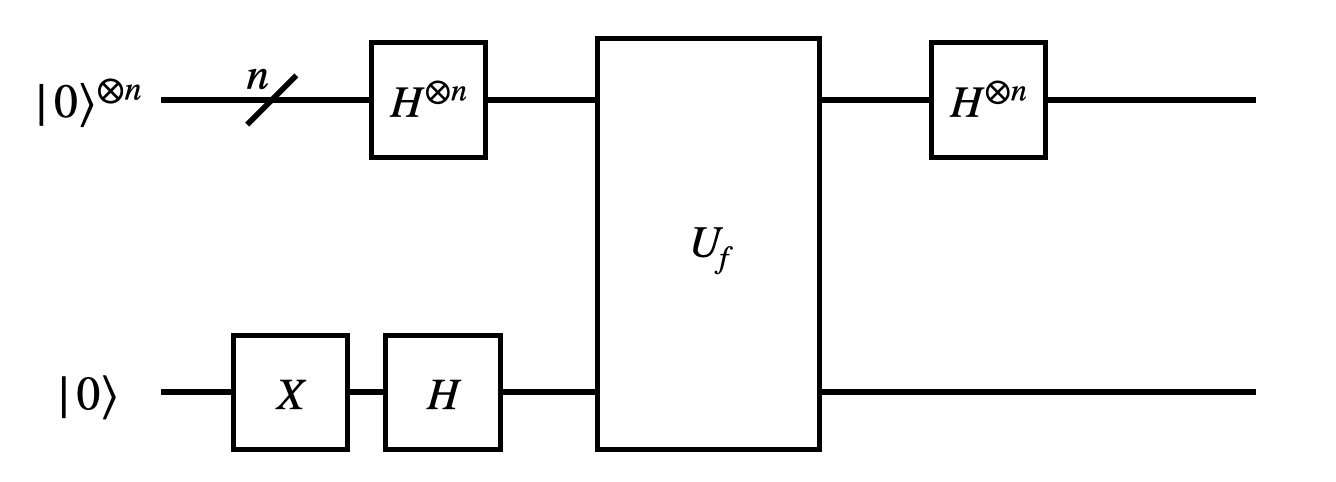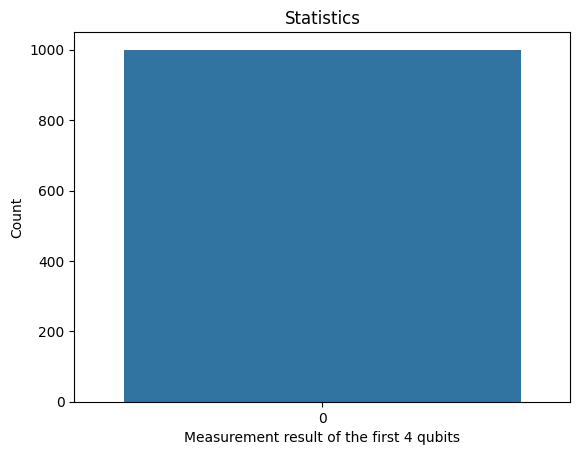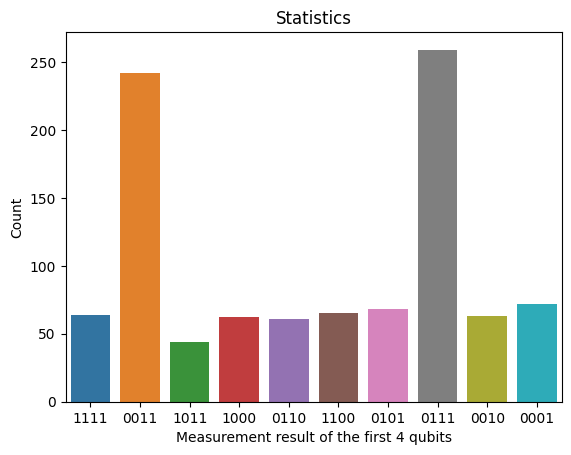The Deutsch–Jozsa algorithm
In this tutorial, some circuits are constructed with the controlled_on option. This is the
experimental multi-controlled circuit feature, which is not yet released in the latest version of QURI Parts.
The Deutsch-Josza algorithm is an algorithm that deterministically solves the following problem:
Given an oracle that implements the function
where is a bit string of length and the function is guaranteed to be either constant (maps all possible bit strings to either 0 or 1[1]) or balanced (map half of the bit strings to 0 and the other half to 1.)
In this example, we demostrate how to use QURI Parts to:
- Build the problem oracle
- Embed the oracle into the solution circuit
- Execute the solution circuit
[1] ^ In the case of constant function, the algorithm works for oracle that implements and . However, without loss of generality, we only build the oracle such that it implements in the case of constant function.
The problem oracle
In this section, we build the oracle circuit with QURI Parts. If the oracle implements a constant function, we simply return a function with no gates. If the oracle implements a balanced function, we randomly pick bit strings out of possible input bit strings that satisfies .
For bit strings of lenth , the oracle is implemented as a circuit with qubits. The first qubits represent the input bit string and the last qubit represents the output. Thus, the oracles are implemented as several multi-controlled X gates where the first qubits are control qubits controlled on those bit strings that makes the function output 1. For example, if , we add a multi-controlled X gate to the circuit where the first 4 qubits are control indices with control values 0, 1, 0, 0.
from numpy.random import choice
from quri_parts.circuit import QuantumCircuit
def get_dj_oracle(n_bit_length: int, balanced: bool) -> QuantumCircuit:
n_qubits = n_bit_length + 1
if not balanced:
return QuantumCircuit(n_qubits)
flipped = choice(2**n_bit_length, size=2**(n_bit_length-1), replace=False)
circuit = QuantumCircuit(n_qubits)
for f in flipped:
controlled_on = {i: (f >> i) & 1 for i in range(n_bit_length)}
circuit.add_X_gate(n_qubits-1, controlled_on)
return circuit
Here, we show the circuit
from quri_parts.circuit.utils.circuit_drawer import draw_circuit
draw_circuit(get_dj_oracle(n_bit_length=4, balanced=True))
#output
0 ----●-------○-------○-------○-------●-------○-------○-------●---
| | | | | | | |
| | | | | | | |
| | | | | | | |
1 ----●-------○-------●-------●-------●-------●-------●-------○---
| | | | | | | |
| | | | | | | |
| | | | | | | |
2 ----○-------○-------○-------●-------●-------○-------●-------●---
| | | | | | | |
| | | | | | | |
| | | | | | | |
3 ----○-------●-------●-------○-------●-------○-------●-------●---
| | | | | | | |
_|_ _|_ _|_ _|_ _|_ _|_ _|_ _|_
| X | | X | | X | | X | | X | | X | | X | | X |
4 --|0 |---|1 |---|2 |---|3 |---|4 |---|5 |---|6 |---|7 |-
|___| |___| |___| |___| |___| |___| |___| |___|
Let's confirm that the circuit does implement the correct oracle
from quri_parts.core.state import ComputationalBasisState
from quri_parts.qulacs.simulator import evaluate_state_to_vector
import numpy as np
import pandas as pd
bit_length = 4
n_qubit = bit_length + 1
oracle = get_dj_oracle(bit_length, True)
function_output_dict = {}
for i in range(2**bit_length):
out_vector = evaluate_state_to_vector(
ComputationalBasisState(n_qubit, bits=i).with_gates_applied(oracle)
).vector
res = np.where(out_vector == 1)[0][0] >> bit_length
function_output_dict[bin(i)[2:].zfill(bit_length)] = res
print(
pd.DataFrame.from_dict(
function_output_dict, orient="index", columns=["function output"]
).reset_index().rename(columns={"index": "function input"}).sort_values(
"function output"
).reset_index(drop=True).T.to_markdown()
)
| 0 | 1 | 2 | 3 | 4 | 5 | 6 | 7 | 8 | 9 | 10 | 11 | 12 | 13 | 14 | 15 | |
|---|---|---|---|---|---|---|---|---|---|---|---|---|---|---|---|---|
| function input | 0000 | 0100 | 0101 | 0110 | 0111 | 1000 | 1011 | 1111 | 0001 | 0010 | 0011 | 1001 | 1010 | 1100 | 1101 | 1110 |
| function output | 0 | 0 | 0 | 0 | 0 | 0 | 0 | 0 | 1 | 1 | 1 | 1 | 1 | 1 | 1 | 1 |
We can see here that the oracle indeed implements a balanced function.
The algorithm
Now, we implement the Deutsch-Jozsa algorithm that determines whether the function is balanced or not. The circuit is given by the below figure.

def get_algorithm_circuit(oracle: QuantumCircuit) -> QuantumCircuit:
n_qubits = oracle.qubit_count
n_func_arg = oracle.qubit_count - 1
circuit = QuantumCircuit(n_qubits, n_func_arg)
circuit.add_X_gate(n_qubits-1)
for i in range(n_qubits):
circuit.add_H_gate(i)
circuit.extend(oracle)
for i in range(n_func_arg):
circuit.add_H_gate(i)
return circuit
As an example, we demonstrate an oracle of 4 qubits embedded inside the solution algorithm
oracle = get_dj_oracle(3, True)
algorithm = get_algorithm_circuit(oracle)
draw_circuit(algorithm)
#output
___ ___
| H | | H |
0 --|1 |-------------○-------●-------●-------●-----|9 |-
|___| | | | | |___|
___ | | | | ___
| H | | | | | | H |
1 --|2 |-------------●-------●-------○-------●-----|10 |-
|___| | | | | |___|
___ | | | | ___
| H | | | | | | H |
2 --|3 |-------------●-------○-------●-------●-----|11 |-
|___| | | | | |___|
___ ___ _|_ _|_ _|_ _|_
| X | | H | | X | | X | | X | | X |
3 --|0 |---|4 |---|5 |---|6 |---|7 |---|8 |---------
|___| |___| |___| |___| |___| |___|
Finally, we run the algorithm with a sampler. The algorithm is deterministic, so one shot is enough to determine if the function is balanced or not.
from quri_parts.qulacs.sampler import create_qulacs_vector_sampler
from quri_parts.core.utils.recording import Recorder, recordable
from collections import Counter
@recordable
def run_algorithm(recorder: Recorder, oracle: QuantumCircuit, n_shots: int=1) -> bool:
"""If function is balanced return 1. Otherwise return 0
"""
algorithm = get_algorithm_circuit(oracle)
sampler = create_qulacs_vector_sampler()
sampling_count = sampler(algorithm, n_shots)
# pick out the measurement result from the first n qubits.
fnc_arg_cnt = Counter()
filter_str = 2**(oracle.qubit_count-1) - 1
for qubit, cnt in sampling_count.items():
fnc_arg_cnt += Counter({qubit & filter_str: cnt})
recorder.info("sampling count", fnc_arg_cnt)
is_balanced = 0 not in fnc_arg_cnt
return is_balanced
We first run the algorithm with an oracle that implements a constant function.
In the Deutsch-Jozsa algorithm, the measured outcome of the first qubits should all be zero.
from quri_parts.core.utils.recording import INFO, RecordSession
import matplotlib.pyplot as plt
import seaborn as sns
import pandas as pd
session_constant = RecordSession()
session_constant.set_level(INFO, run_algorithm)
with session_constant.start():
oracle = get_dj_oracle(4, balanced=False)
print("is balanced:", run_algorithm(oracle, 1000))
constant_group, = session_constant.get_records().get_history(run_algorithm)
ax = sns.barplot(
pd.DataFrame.from_dict(
constant_group.entries[0].data[1], orient='index', columns=["count"]
).T
)
ax.set(
xlabel = "Measurement result of the first 4 qubits",
ylabel = "Count",
title = "Statistics"
)
plt.show()
#output
is balanced: False

Finally, we run the algorithm with an oracle that implements a balanced function.
session_balanced = RecordSession()
session_balanced.set_level(INFO, run_algorithm)
with session_balanced.start():
oracle = get_dj_oracle(4, balanced=True)
print("is balanced:", run_algorithm(oracle, 1000))
balanced_group, = session_balanced.get_records().get_history(run_algorithm)
table = pd.DataFrame.from_dict(
balanced_group.entries[0].data[1], orient='index', columns=["count"]
).T
table.columns = list(map(lambda x: bin(x)[2:].zfill(4), table.columns))
ax = sns.barplot(table)
ax.set(
xlabel = "Measurement result of the first 4 qubits",
ylabel = "Count",
title = "Statistics"
)
plt.show()
#output
is balanced: True
